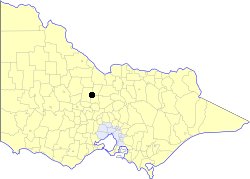City of Bendigo
| City of Bendigo Victoria | |||||||||||||
|---|---|---|---|---|---|---|---|---|---|---|---|---|---|
 Location in Victoria | |||||||||||||
|
Town Hall | |||||||||||||
| Population | 30,890 (1992)[1] | ||||||||||||
| • Density | 949.58/km2 (2,459.4/sq mi) | ||||||||||||
| Established | 1855 | ||||||||||||
| Area | 32.53 km2 (12.6 sq mi) | ||||||||||||
| Council seat | Bendigo | ||||||||||||
| County | Bendigo | ||||||||||||
 | |||||||||||||
| |||||||||||||
The City of Bendigo was a local government area covering the central area and inner western suburbs of the regional city of Bendigo, Victoria, Australia. The city covered an area of 32.53 square kilometres (12.6 sq mi), and existed from 1855 until 1994.
History
The City of Bendigo was first incorporated as the Sandhurst Municipality on 24 April 1855, and became a borough on 11 September 1863 and a city on 21 July 1871. It was renamed as the City of Bendigo on 8 May 1891.[2]
On 7 April 1994, the City of Bendigo was abolished, and, along with the Borough of Eaglehawk, the Rural City of Marong and the Shires of Huntly and Strathfieldsaye, was merged into the newly created City of Greater Bendigo.[3][4]
Wards
The City of Bendigo was divided into three wards, each of which elected three councillors:
- Barkly Ward
- Darling Ward
- Sutton Ward
Suburbs
- Bendigo
- Golden Square
- Ironbark
- Long Gully
- North Bendigo
- Quarry Hill
- West Bendigo
- White Hills
Population
| Year | Population |
|---|---|
| 1954 | 28,726 |
| 1958 | 30,700* |
| 1961 | 30,195 |
| 1966 | 30,792 |
| 1971 | 32,007 |
| 1976 | 32,573 |
| 1981 | 31,841 |
| 1986 | 30,704 |
| 1991 | 30,134 |
* Estimate in the 1958 Victorian Year Book.
References
- ↑ Australian Bureau of Statistics, Victoria Office (1994). Victorian Year Book. p. 52. ISSN 0067-1223.
- ↑ Victorian Municipal Directory. Brunswick: Arnall & Jackson. 1992. pp. 308–309. Accessed at State Library of Victoria, La Trobe Reading Room.
- ↑ Municipal Association of Victoria (2006). "Greater Bendigo City Council". Retrieved 2008-01-08. Date cross-checked with the Records Division, Greater Bendigo City Council.
- ↑ Taylor, Thomas (6 April 1994). "Marong to fall in line on super council". The Age. p. 6. Accessed via Factiva online.
Coordinates: 36°45′S 144°16′E / 36.750°S 144.267°E